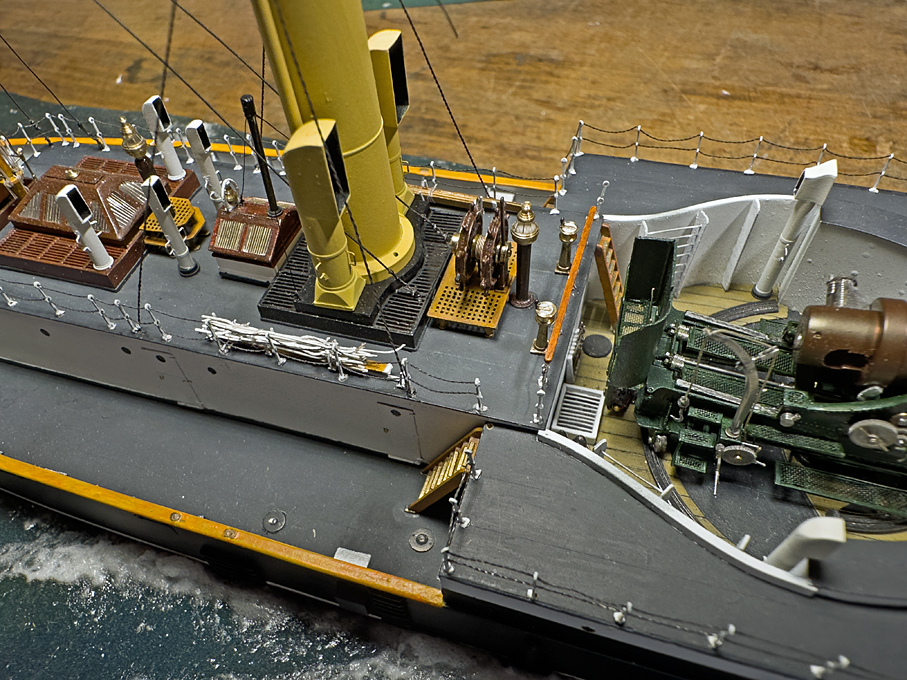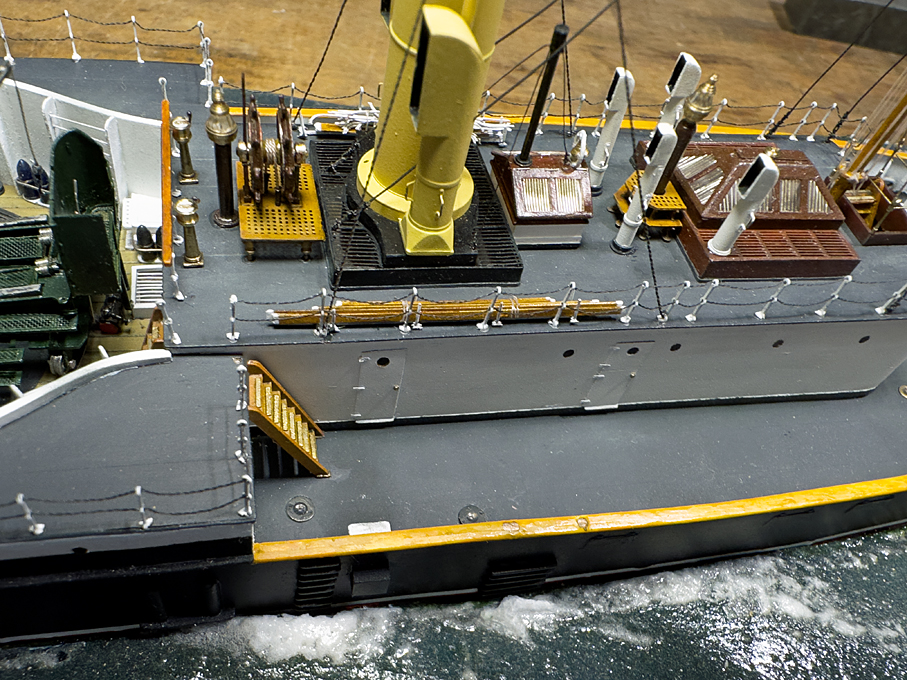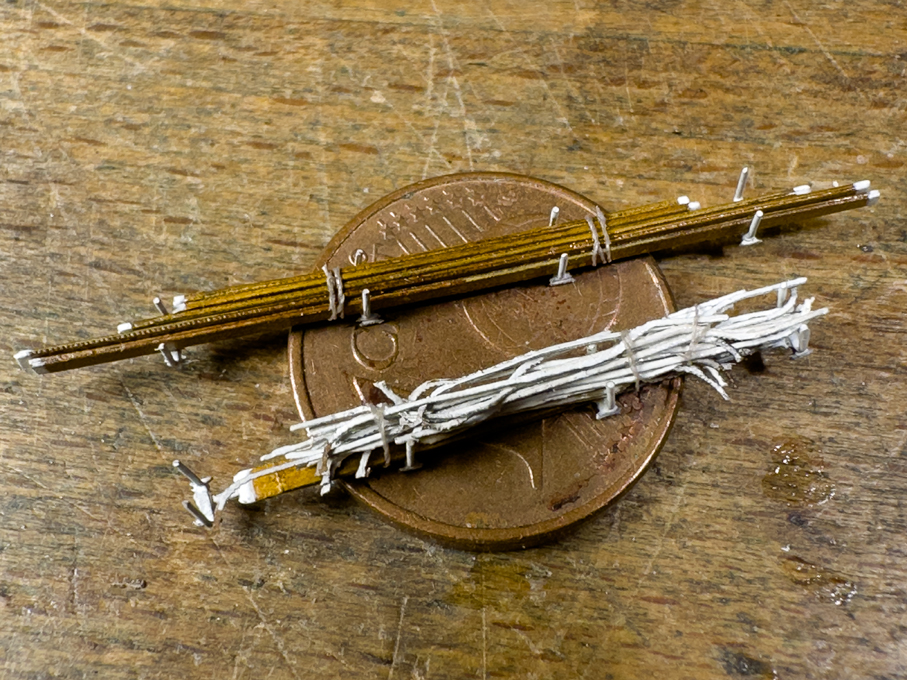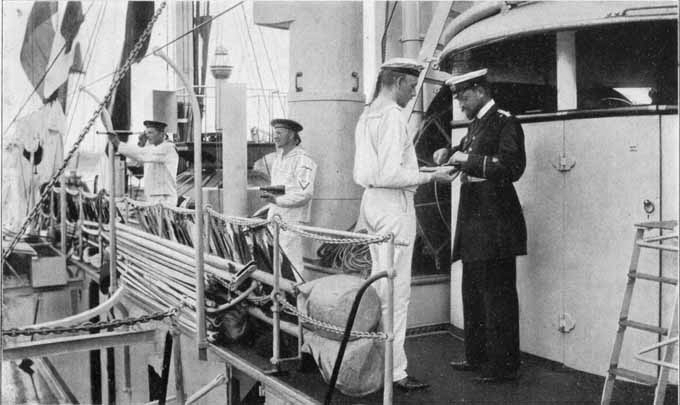-
Posts
6,637 -
Joined
-
Last visited
Content Type
Profiles
Forums
Gallery
Events
Everything posted by wefalck
-
I love this old-time steam-technology ... Over here in Europe, of course, we also have narrow-gauge rotary steam-plows. Here is a video from the Bernina Pass of the Rhatian Railway in Switzerland: https://youtu.be/oGndpEPgEgw?feature=shared They keep the line open all year around at least to the Italian border. A couple of James Bond ski pursuits were filmed in the area, particularly on the Morteratsch glacier. I used to ski there, when I was a student.
-

HMCSS Victoria 1855 by BANYAN - 1:72
wefalck replied to BANYAN's topic in - Build logs for subjects built 1851 - 1900
Good to see your progress. Making these bits and pieces 'bolted' to booms and gaffs from wood is always fiddly and requires real high-quality dense wood. In the past I have used paper-thin styrene sheet for such bands on wooden booms and gaffs because with liquid cement you can kind of 'melt' them around. However, they turned out to be quite brittle when drilling for the ring-bolts etc. I think today, I would also make them from paper soaked in varnish. However, in really small scales I now turn spars from steel rod and actually turn the bands on as far as possible. For the bands around the jaws this is obviously not possible ... I wouldn't mind to see a picture of VICTORIA in her current whole state of beauty 😉- 1,013 replies
-
- gun dispatch vessel
- victoria
-
(and 2 more)
Tagged with:
-
The shipyard re-opened in early September after a long summer-break that I spent away from the workshop, but it was followed by various business and private travels. So, producing the small detail below took an awful lot of time … Some ‘clutter’ on the deck-house I found producing the stanchions for the awnings too much of a challenge at this small scale and didn’t like the look of them anyway. So, I did not install them on the model (and even omitted their sockets, as I did not have any information on how these really looked like). My excuse was that the model will be shown in a semi-battle-ready gun-exercise situation, where the stanchions would be stowed. Photograph showing awning-stanchions in a storage rack on the deckhouse There are quite a few stanchions, which are tapered and slightly curved at the upper end with the ring. The upper section is round, while the lower section that fits into the sockets is square. According to one picture available, it seems that the stanchions were stowed in sort of racks along the rails of the deck-house when not in use. The same applied presumably to the wooden beams that formed the centre ridge of the awnings. Mass-producing these stanchions that would be barely seen, when stowed in the rack, from brass-wire seemed a disproportionate effort. Hence, I decided to laser-cut them from card-stock. They are very flimsy and were stiffened in varnish before proceeding them to paint them with acrylic paint. The paint was applied quite generously to have a sort of rounding effect. The two racks ready for installing on the model I could not find any picture that showed the stowing racks, so I had to invent something that seemed reasonable. Somehow the racks seem to be associated with the rail-stanchions. I devised a sort of cage with a laser-cut base and uprights made from thin tinned copper-wire. The racks also accommodate the (foldable) wooden beams that support the awnings amidship. In addition, it seems that the mops etc. for the gun were stored in these racks. The racks installed To be continued ....
-
These 'colonial' sternwheeler have captured my imagination since childhood and one day I should build one ... In Germany, one yard specialised on such vessels was the Meyer-Werft in Papenburg (who also produced the famous steamships in kit form for the East African lakes that formed the background for 'African Queen'). On a German forum a colleague presented his project for such a steamer: https://forum.arbeitskreis-historischer-schiffbau.de/viewtopic.php?f=30&t=1288. Apart from the hull the model is mainly build from brass, given the fragile superstructure: Going through the building log is well worth (with Google translator). Good luck for your project!
- 128 replies
-
- zulu
- sternwheeler
-
(and 1 more)
Tagged with:
-
On these small ships typically every second or third frame ran up to the level of the main rail and served as stanchions for the bulwark. On larger ships the stanchions were separate timbers that were attached to the top of the frames. The 'monkey-rail' serves to heighten the bulwark in parts or all along the ship. Short stanchions were set into the main rail where the top of the main stanchions were. These stanchions carry a rail that is thinner and narrower than the main rail. The outside can be planked or the space between the stanchions left open.
-
I didn't check against my photographs, but it is probable that the 'shelves' inside the bulwarks are actually the pin-rails. These rails took up the belaying pins on which various rigging lines would be fastened. There were various ways in which these pin-rails were constructed. Sometimes they were bolted simply in front of the bulwark stanchions and sometimes they were notched for the stanchions. A third version, which I think was not used on GJØJA was to widen the main rail to take up the belaying pins. If a monkey-rail was fitted, this may look like a shelf that runs down the whole length of the ship. However, I think GJØJA had simple bulwarks without monkey-rail.
-
Perhaps you should post your question here: https://www.segelschiffsmodellbau.com/ I used to live in Berlin, but since leaving in 1999 the shop-landscape has changed dramatically ... in any case, you have to be prepared to move around the city, there is nothing in the Museum Insel area. There is a sort of materials warehouse, mainly catering for architectural model building: https://www.modulor.de. It is very good for all sorts of materials, but less so for the sort of woods shipmodel builders are looking for.
-
It seems that the term 'holy-stone' came from the fact that the RN obtained their stones from a quarry on the Isle of Wight that also supplied the local cemeteries. I don't recall the exact date and source, but around the middle of the 19th century the RN greatly reduced the 'holy-stoning' as it was found (obviously) that it wears the deck-planks thin prematurely and thus adds to the cost of upkeeping.
-
Who would maintain the guns, the sailors or the marines? Cast-iron guns at see need constant maintenance to prevent them from becoming rusty ...
-
Ripped ladies' stocking would make reasonable fishing nets. I have also used various seeds to represent, after painting, different type of fruit. Pepper-corns could make a basis for melons (not sure about the size/scale in your case).
- 286 replies
-

French Atlatinc Coast (Ports, Forts, Arsenals and similar)
wefalck replied to Blas de Lezo's topic in Nautical/Naval History
Fort Boyard cannot be visited by individuals, as far as I know. However, there may be excursions from Rochefort to the Île-de-Aix by boat that take a tour around the fort. The Island itself has various fortifications that can be visited freely. In the context of the great model show in Rochefort in 2018 we made such a tour, but this was not a regular boat. -

Mini self contained airbrush
wefalck replied to Bill Hudson's topic in Modeling tools and Workshop Equipment
I have a 'normal' airbrush only and would venture the guess that, while it looks neat, it would not be very handy for detail work, given the bulky air container. I wonder also, for how long the battery charge would last. -

French Atlatinc Coast (Ports, Forts, Arsenals and similar)
wefalck replied to Blas de Lezo's topic in Nautical/Naval History
The site of the Musée de la Marine is a good starting point: https://www.musee-marine.fr -
It is not unusual for small craft to have no capping rail at all, particularly, when they were clinker built, where the longitudinal strengthening provided by it would not be needed. The strange thing however, is to have a capping rail that actually does not cover the frame-heads. It may well be that they added this plank to provide better seating, when sailing, as you would like to balance the boat with your body. Who knows? The builders may not have been aware of the various boat-building techniques and just build something simple that did the job. As many of us are sort of rooted in the naval or yachting tradition, where everything had to be 'ship-shape - Bristol fashion', we tend to forget that such craft were built for plain functionality and not following any established traditions in craftsmanship.
- 286 replies
-
OK, photographic evidence has precedence, but this construction appears to be rather unconventional. A capping rail is called a capping rail, because it caps the heads of the frames. In addition to adding longitudinal strength it also protects the end-grain of the frame-heads from deterioration. Handcoloured photographs typically reflect the expectations or conventions of the colourists. It would be interesting to know, whether these boats were painted outside or tarred. In many regions of the world, boats are just repeatedly given light coats of tar. With the weathering, this would take on a mottled, greyish-brown look as in the coloured photograph above. However, whoever coloured the photographs may have been guided by the visual image of boats e.g. in the USA or Europe.
- 286 replies
-

Printable scale rulers
wefalck replied to FlyingFish's topic in Modeling tools and Workshop Equipment
Indeed, paper is a living object and shrinks/expands in different directions as e.g. a function of humidity. The only way to verify dimensional accuracy is to compare measurements against the drawn scale with data given numerically, either on the drawings themselves or through other sources. This requires that the measuring points of the numerical data can be uniquely identified in the drawing, which often is difficult. "... exact data at each station" - this actually looks as if you were using chain measurements. Are you checking the overall accuracy then against any total length taken off the body plan etc. ? -

Printable scale rulers
wefalck replied to FlyingFish's topic in Modeling tools and Workshop Equipment
Bob, you are absolutely right, when it concerns 'modern' engineering drawings or builder's plans. Here, the dimensions (incl. tolerances and surface qualities) indicated are the reference for laying out parts. I was referring to the 18th/19th century ship's plans or modern reconstruction drawing. There you normally find a scale drawn on the bottom of the drawing. The classical method would be to take off lengths with a compass and read the dimensions on the scale. For many years now I am using a sort of digitised procedure: I import a scan of the drawings into my 2D CAD program, where the internal scale is set appropriately. I then redraw what I need in a different layer and can read the dimensions at model scale directly on the computer. I always work 'outside-in', rather than concatenating parts in order to avoid cumulative errors. For machining parts, I print out the part in a larger scale and note down the micrometer readings needed, based on the data in the CAD. -
The coverage is a bit uneven across Europe, but there are hundreds of (scientific or semi-scientific) books or papers with plans. These are reconstruction plans based on documented evidence and not edited for modellers. Concerning the Iberian Peninsula, the coverage of Portugal is pretty good (thanks also to the museum in Bélém/Lisbon), while the coverage for Spain seems to be a bit more patchy - there is no 'national' maritime museum, only the very good naval museum in Madrid, which however does not cover vernacular craft. It may be a bit tedious to go through all the 178 pages of my literature list (https://www.maritima-et-mechanika.org/maritime/maritimebibliographies/maritimebibliography.pdf), but you can find there references to literature on boats across Europe and worldwide.
About us
Modelshipworld - Advancing Ship Modeling through Research
SSL Secured
Your security is important for us so this Website is SSL-Secured
NRG Mailing Address
Nautical Research Guild
237 South Lincoln Street
Westmont IL, 60559-1917
Model Ship World ® and the MSW logo are Registered Trademarks, and belong to the Nautical Research Guild (United States Patent and Trademark Office: No. 6,929,264 & No. 6,929,274, registered Dec. 20, 2022)
Helpful Links
About the NRG
If you enjoy building ship models that are historically accurate as well as beautiful, then The Nautical Research Guild (NRG) is just right for you.
The Guild is a non-profit educational organization whose mission is to “Advance Ship Modeling Through Research”. We provide support to our members in their efforts to raise the quality of their model ships.
The Nautical Research Guild has published our world-renowned quarterly magazine, The Nautical Research Journal, since 1955. The pages of the Journal are full of articles by accomplished ship modelers who show you how they create those exquisite details on their models, and by maritime historians who show you the correct details to build. The Journal is available in both print and digital editions. Go to the NRG web site (www.thenrg.org) to download a complimentary digital copy of the Journal. The NRG also publishes plan sets, books and compilations of back issues of the Journal and the former Ships in Scale and Model Ship Builder magazines.








